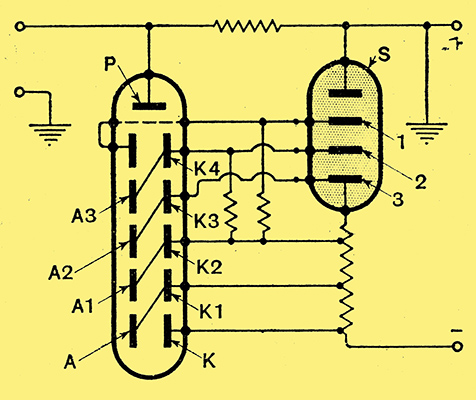|
Improving operation by stabilisation of supply voltage.

Stabilising the supply voltages of an electron multiplier by means of a gas-filled tube S
The electron multiplier is one of the latest and most promising additions to the family of amplifiers. It makes use of what may be called 'controlled' secondary emission to intensify the relatively feeble currents produced, for instance, by the action of light on a photo-sensitive surface. As shown in the accompanying diagram, the few electrons first liberated by a ray of light falling on to the 'cold' photo-electric cathode K are subjected simultaneously to a strong magnetic; field from an a external coil (not shown) and to the electrostatic pull exercised by a positively biased plate A. The combined effect of the two control forces causes the electrons to follow a curved path so that they strike against a target electrode marked K1.
The impact liberates a fresh supply of secondary electrons, which reinforce the others, and the augmented stream is again compelled, by the combined electric and magnetic control fields to follow a similar curved path on to a second target electrode K2, where still more secondary electrons are liberated. The process is repeated, stage by stage, until a greatly,amplified current is finally drawn off by the output plate P into the external circuit.
To ensure stable operation, it is essential that each of the target electrodes K - K4 should carry a fixed and progressively increasing voltage. If the electrodes are connected to tappings on an ordinary potentiometer, the current flowing through the resistances, particularly those associated with the more-positive, targets, will be sufficient to cause undesirable variations in the supply voltages.
The difficulty can be avoided, according to Patent No. 478153, by using a gas-filled 'Stabilovolt' tube S, in place of an ordinary potentiometer. The supply volt ages taken off from the spaced electrodes I, 2, 3 to the upper target electrodes of the multiplier will then remain constant, irrespective of variations in the load taken by the different targets. Such an arrangement helps to prevent distortion, particularly of the higher frequencies, when the electron multiplier is used, say, to amplify a wide range of television signals prior to transmission.
|